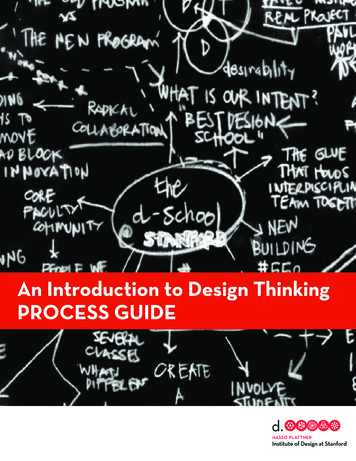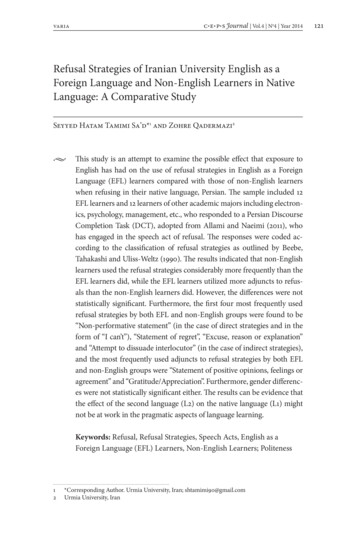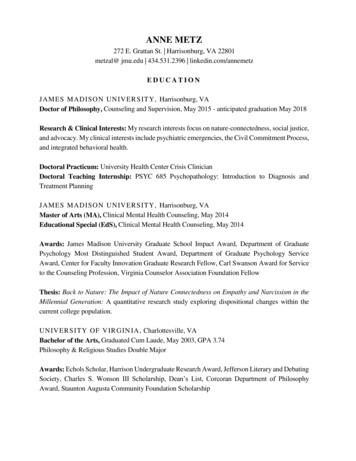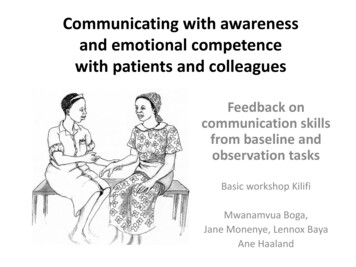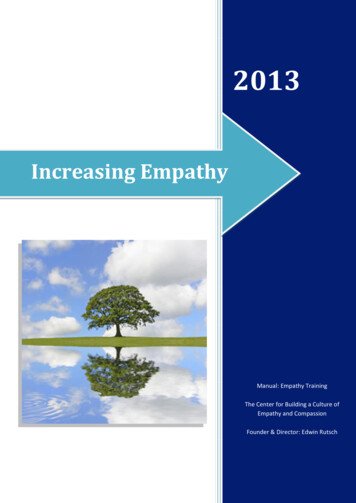
Transcription
2013Increasing EmpathyManual: Empathy TrainingThe Center for Building a Culture ofEmpathy and CompassionFounder & Director: Edwin Rutsch
Content1Introduction . 32Objectives . 53Didactic model . 64Evaluation . 7Module 1: Self Empathy . 8Module 2: Accepting others . 14Module 3 Accurate listening . 19Module 4: Perspective Taking . 26References . 31Appendix. 33Enclosure 1: Questionnaire . 34Enclosure 2: Explanation FFMQ and the perspective taking scale . 36Enclosure 3: Hand-out 1: Tips for the Body-scan . 37Enclosure 4: A story to tell . 38Enclosure 5: Stories from the news to tell . 39Enclosure 6: Hand-out 2: Exercise to practice accurate listening . 40Enclosure 7: Reading Micro expressions. 41Enclosure 8: Recognizing the Expressions—The Answers . 55Enclosure 9: Hand-out 3: Accurate listening in real-life situations . 57Enclosure 10: What do you see? . 58Enclosure 11: Perception Cards . 59Enclosure 12: Survey . 60Manual Empathy Training - 20132
1 IntroductionThis training is developed for The center for Building a Culture of Empathy and Compassion (CBCEC).The reason for developing this training is the motivation of Edwin Rutsch to build a culture ofempathy and compassion.Edwin Rutsch is the founder and director of CBCEC and thinks fostering empathy is importantbecause it helps to resolve conflicts and improve the connection between each other. Furthermore itleads to a broader awareness and more openness to new insights.This is confirmed by the literature because research has shown that being empathic with each otherand listen to each other leads to conflict resolution and a bigger connection between individuals(Davis & Oathout,1987; Long, Angera, Carter, Nakamoto, & Kalso, 1999). Moreover empathy leads toa broader awareness (Rogers, 1982).Lastly literature confirms that fostering empathy is important because it reduces bullying, prejudiceand racism and increases the will of individuals to help others in need (Dixon, 2011; Gordon, 2012;Davis, 1980; Eisenberg & Miller, 1987). In Short, Empathy is a building block for a better society.The main goal of this training is that the participants1 can apply the learning materials from thistraining in real life situations to be able to be empathic with themselves as with others. The targetgroup of this training concerns 18 adults with different ethnical backgrounds.This empathy training is based on the insights of Carl Rogers. This because Edwin Rutsch is interestedin the insight from Rogers. Rogers (1995)defines empathy as follows:“An empathic way of being with another person has several facets. It means entering theprivate perceptual world of the other and becoming truly at home in it. It involves beingsensitive, moment by moment, to the changing felt meaning which flow in this other person,to the fear or tenderness or rage or confusion or whatever the other person is experiencing.It means to temporarily living in the others perceptual world and moving in it delicatelywithout making judgments; it means sensing meanings of which the other is scarcely aware,but not trying to uncover totally unconscious feelings because this can be to threatening. Itincludes communicating your sensing’s of the person’s world as you look with fresh and unfrightened eyes at elements of which he or she is fearful. It means frequently checking withthe other person as to the accuracy of your sensing’s, and being guided by the responses thatyou receive. You are a confident companion to the person in his inner world. By pointing tothe possible meanings in the flow of the other person’s experiencing, you can help him tofocus on this useful type of referent. This way the other person can experience the personalmeanings more fully and move forward in the experiencing.” (pp.142)According to Rogers, in order to empathize with others, it is important to show unconditionalpositive regard, listen accurately and be able to take the perspective of others (1982). Unconditionalpositive regard means to not judge others but to accept them for who they are, both positive andnegative sides and to acknowledge that they all are self-determining individuals. Showingunconditional positive regard towards others is important because it gives them the knowledge thatthey are just as important as everybody else and they are more likely to think “if he isn’t judging meand allows me for who I am, I am maybe not that strange person I always thought I was”. People whoreceive unconditional positive regard are more likely to show it towards themselves and start toempathize more with themselves (Rogers, 1982).1In this manual the participants are described with he or him. Of course the participants are men as well as women but tomake this manual more readable, constructions like he/she or he or she are being avoid (with the exception of thedefinition of Empathy from Rogers because this is a quote).Manual Empathy Training - 20133
Accurate listening means listening sincerely interested at the speaker and being able to reflectfeelings and thoughts of the speaker accurately. This is an important aspect because by listeningaccurately you can communicate your sensing’s of the other person’s world correctly and help him tounderstand his own feelings, thoughts and personal meanings and becoming congruent with himself.Eventually this can lead to a broader awareness and more openness to new insights. Furthermore bylistening accurately to others you can create deeper connections with them (Rogers, 1982).Perspective taking means to enter the perceptual world of the other and experiencing the feelingspersonal meanings and thoughts of the other person. This is important because it increases theability to really understand the other person (Rogers, 1982).Literature confirmed that the ability to empathize with others can be increased by at first learninghow to be self empathic , observing without interpretations and by acknowledging others as selfdetermining individuals. Furthermore by practicing in accurate listening and recognizing expressions.Finally by learning that the own references are not universal. The content of this training is based onthese findings. Within this training there is room for a maximum of twelve participants to a minimumof six participants.This training can be facilitated in a face to face setting. Furthermore with some adjustments in theexercises it is possible to facilitate parts of this training in an online setting.Manual Empathy Training - 20134
2 ObjectivesBased on the findings from desk research, the following learning objectives are formulated.Mean learning objectiveI.After the training, the participant knows how to be empathic towards himself and can applyit in real life situations.Learning objectives1. After the training, the participant can listen to his inner experiences and is connected withthe sensations in his body.a. the participant can regulate his attention and focus it on the inner mental and physicalevents in the present moment and is able to name it.b. the participant can observe his own mental and physical events in the present momentwithout judging.Mean learning objectiveII.After the training, the participant knows how to be empathic towards others and can applythis is real life situations.Learning objectives2. After the training, the participant is able to accept others without judging.a. the participant can observe others without judging by recognizing inner thoughts,feelings or judgments and letting them go.b. the participant can acknowledge the other as self determining individual by telling.3. After the training, the participant can listen accurately.a. the participant can listen to the speaker without adding.b. the participant can reflect the feelings, thoughts and intentions of the speaker correctly.c. the participant is aware of the different expressions and can recognize at least a coupleby telling which emotion is shown.4. After the training, the participant is able to take the perspective of the other.a. the participant is aware of the fact that every individual has his own point of view andknows the own perspective is not universal.b. the participant can enter the perspective of the other by focusing the attention on thedifferences between himself and others and by temporarily putting aside the ownreferences.Manual Empathy Training - 20135
3 Didactic modelThis training consists out of four modules each with a duration of 4 hours, excluding module 2 whichtakes 3 hours. The structure of this training is based on a Dutch model called OPOE-model. Thismodel stands for Orientation, Presentation, Assignment and Evaluation (Hoobroeckx & Haak, 2002).Every module will begin with a brief review on the previous module and the homework assignments.Thereafter the trainer presents the subject and learning objectives of the current module and asks ifthe participants can share something about it. In addition to the input of the participants, the trainercan present more information about it. Next the participants will perform different assignments topractice the learning materials. At last the module will be completed by a short evaluation. Themethod of evaluating will be various depending on the learning objectives (see chapter 4).Global structure of the modules:Opening:(1th module, introducing yourself and the whole Empathytraining)Review on previous training and discussion of the homeworkassignments.Orientation:Present the subject of the current module and askif the participant can or like to share something about it.Presentation:Present additional information about the subject of the module.Assignments:Let the participants perform different assignments topractice the learning material.Evaluation:End the module by evaluating it.In this manual, all the activities of the trainer are described in ‘steps’. Each step describes theduration of it, the materials that are necessary, the goal of the activity and the correspondinglearning objectives. At last every step contains an explanation. These explanations consist ofinformation the trainer can present to the participants and directions to perform an exercise.When you are going to facilitate this training it is important to first read this manual before the startof the training. This way you know exactly what to do and how to follow the steps.Manual Empathy Training - 20136
4 EvaluationTo monitor if the content of this empathy training can reach the learning objectives, it is important toevaluate. Based on evaluation, this empathy training can keep improving to reach its goals.This training can be evaluated on different ways.Learning objectives 1, 2 & 4 and 1a, 1b, 2a, 4a & 4b can be measured by the Five Facet MindfulnessQuestionnaire (FFMQ) (Baer, et al., 2008) and the perspective taking scale from the InterpersonalReactivity Index (IRI) from Davis (1980). These two questionnaires can by implemented in the firstmodule of this training, and two weeks after the last module of this training. This way there will be apre- and post measurement that indicates if the content of the training helps reaching the objectives.In enclosure 1 you can find a combined survey of both questionnaires and in enclosure 2 informationabout the scoring.Learning objective 2d can be measured by discussing it during the training after practicing it.Furthermore learning objectives 3, 3a, 3b & 3c can be measured by the participants. During thistraining all participants are getting the opportunity to practice accurate listening in different settings,by reflecting what they’ve heard the other say. The speaker can say how well he has been heard andempathized with. In short, the participants are giving feedback to each other and receiving feedbackfrom each other. This feedback can indicate if the participants reached the objectives.During this training the participants also have the opportunity to share their experiences and opinionabout the training and if they have any other additional things they would like to say. But becausethis isn’t a very anonymous way to share opinions, the risk of a social desirable response from theparticipants is high. To make sure the information from the participants about the training is reliable,the participants receive a short survey in which they can share their opinions and experiences of thistraining anonymously.Lastly the trainers can make suggestions to adjust this training based on their opinions andexperiences with this training.Manual Empathy Training - 20137
Module 1: Self EmpathyTime:4 hoursMaterials:Flap-over, marker, enclosure 1, 2 & 3MeanObjective:Learningobjectives:After the training, the participant knows how to be empathic towards himself andcan apply it in real life situations.After the training, the participant can listen to his inner experiences and is connectedwith the sensations in his body.a. The participant can regulate his attention and focus it on the inner mental andphysical events in the present moment and is able to name it.b. The participant can observe his own mental and physical events in the presentmoment without judging.Step 1Introduction0:00-0:30Step 2Pre-measurement0:30-0:45Step 3Exercise 1: know each other well0:45-2:00Step 4Break2:00-2:30Step 5Exercise 2: body scan meditation2:30-3:00Step 6Exercise 3: allowing what is3:00-3:30Step 7Exercise 4: hugging practice3:30-3:45Step 8Ending the module3:45-4:00Summary :In this Module the participants will learn how to listen to their own physicaland inner mental experiences. Furthermore they will learn to allow andaccept what is and to be kind towards themselves by hugging.Manual Empathy Training - 20138
Step 1: introductionTime:30 minMaterials:Nametags & markersExplanation:To start this training about empathy, it is important to first introduce yourself. Forexample you can tell something about yourself, your background and why you thinkempathy is important. You can also sum up other benefits of empathy. For example:- empathy reduces prejudice and racism;- empathy reduces bullying;- empathic people are more likely to help others in need (Davis, 1980; Dixon,2011; Eisenberg & Miller, 1987; Gordon, 2012).Furthermore you can present the learning objectives (see above) of this module. Youcan also explain that in this module it is important to work on self-empathy becausethis increases the ability to be empathic with others (Miller, 2009; Rogers, 1982). Inother words to be able to help and accept others and care for them, it is important tofirst help and accepts yourself and care for yourself.Finally you can ask the participants to shortly introduce themselves by telling theirnames and ask what motivates them to join this training. You can also give theparticipants their nametags so it would be easier to remember their names.Step 2: pre measurementTime:15 minMaterials:Enclosure 1 & 2, pencilsGoal:To monitor the progress in reaching learning objectives 1, 2 & 4 and 1a, 1b, 2c, 4h &4iExplanation:Before the training goes any further, it is important that the participants fill in acombined survey based on two test concerning the perspective taking scale fromDavis (1980) and the Five Facet Mindfulness test from Baer, et al., (2008). Inenclosure 1 you can find the survey. In enclosure 2 you can find a short explanationon how to implement it and information about the scoring. The intention of thismeasurement is described in chapter 4 Evaluation.Step 3: Exercise 1 know each other wellTime:1 hour and 15 minMaterials:Flap-over and a markerGoal:To let the participants get to know each other and to let the participants share theirexpectations of the training with each other to create a good atmosphere.Explanation:It is important that the participants really get to know each other. This becausethe participants have different ethnical backgrounds and little or inaccurateinformation about each other. This inaccurate or vague information can lead toprejudices, stereotypes and an unpleasant atmosphere (van Oudenhoven & van derZee, 2006). So to make a sphere in which participants feel safe and free to fullyManual Empathy Training - 20139
express themselves, it is important that they get to know each other well (Allport,1954 as quoted in van Oudenhoven & van der Zee, 2006).Put a schedule with numbers on the flap-over and give every participant anumber from one to twelve. For example see Figure 1: Exchange scheme.1th round 1 2 3/4 5 6/7 8 9/10 11 122th round 1 4 7/ 2 8 10/ 3 5 11/ 6 9 123th round 1 5 9/ 2 7 11/ 3 6 10/ 4 8 124the round 1 6 11/ 2 4 9/ 3 7 12/ 5 8 10FIGURE 1: EXCHANGE SCHEMELet the participants form the groups and ask them to shake hands and talk about whythey take part in this training and which problems they hope to solve by followingthis training. After 15 minutes the group comes together and form the new groupsaccording to the schedule. This will be repeated four times.According to Oomkes (1995), this exercise is suitable to ease the participants.Furthermore the participants will get to know each other well.Step 4: BreakTime:30 minStep 5: Exercise 2 Body scan meditationTime:30 minGoal:Learningobjective:Explanation:To let the participants practice in regulating the own awareness to the inner mentaland physical events in the present moment and to get connected with them.The participant can regulate his attention and focus it on the inner mental andphysical events in the present moment and is able to name it.The purpose of this exercise is to pay attention to the inner experiences. Thisbecause according to Rogers (1982) the first step to be able to accept others and carefor them, is to be aware of the own inner experiences. This can be practiced byperforming some mindfulness exercises.Let the participants make themselves comfortable and allow them to close their eyesgently. Follow the steps below to practice the body-scan with them (Beuningen2011).1. Take a moment to get in touch with the movement of your breath and thesensations in your body.2. Bring your attention to the physical sensations in your body. Especially to thesensations of touch or pressure.3. Remind the intention of this practice. The goal is not to feel different, relaxed orcalm. This may or may not happen. But the intention is to bring attention to anysensations you detect, as you focus your attention on each part of the body inManual Empathy Training - 201310
turn.4. Whatever feelings, thoughts and/or physical sensations you are experiencing,accept them without judging the experiences as they are, and let them go.5. Bring your awareness to the physical sensations in the lower abdomen andbecome aware of the changing patterns of sensations in the abdominal wall asyou breathe in, and breathe out.6. Bring your focus to the toes of your left foot. Feel all the sensations in your toesof your left foot with a kind and curious attitude.7. On a inhalation imagine or feel the breath entering the lungs, and then passingdown into the abdomen, into the left leg, the left foot, and out through the toesof the left foot. Thereafter, imagine or feel on an exhalation the breath comingall the way back up from the toes out of the foot, into the leg, up through theabdomen, chest, and out through the nose.8. On an exhalation let go of awareness of the toes, and bring your awareness tothe sensations on the bottom of your left foot bringing a gentle, investigativeawareness to the sole of the foot, the instep, the heel etc. Again imagine howyour breath flows from the foot through your body to the nose.9. Now move your awareness to the ankle, your lower leg to the knee and thenyour whole left leg.10. Now we are going to do the same with your right leg. Focus your awareness to althe sensations in that body part. The toes of your right foot, foot, heel, top of thefoot, ankle, lower leg, knee, thigh and then your whole right leg.11. Next, bring your awareness to your breathing and thus your abdomen, chest,back, left arm, right arm, neck, head and face.12. If you become aware of tension, or of other sense of other intense sensations ina particular part of your body, than try to notice it in a friendly way and try to letit be.13. During this exercise your mind will inevitably wander away from the breath andthe body from time to time. That is entirely normal. If you notice this, thenacknowledge that in a friendly way, and notice where your attention drifted toand again focus your attention on the part of the body were you want to focuson.14. After the participants have "scanned" their whole body in this way, let themspend a few minutes being aware of the sense of the body as a whole, and of thebreath flowing freely in and out of their body.Closure:After performing the body scan with the participants you can ask them to share theirexperiences.Manual Empathy Training - 201311
Step 6: Exercise 3 Allow and accept what isTime:30 minGoal:Learningobjective:Explanation:To learn the participants how to allow and accept what is.The participant can observe his own mental and physical events in the presentmoment without judging.As previously described, according to Rogers (1982) being aware of our positive andnegative thoughts and feelings and accept those is important because this willincrease the ability to accept others. Furthermore kindness towards ourselves isimportant because this allows us to help others and showing compassion towardstheir shortcomings (Neff, 2011) .Accepting others and care for them is one of the important aspects of empathydescribed by Rogers (1982). Perform the next exercise to allow and accept what is.1. The first step is to close your eyes and notice where your attention is located inyourself, and to approach it in a friendly way.2. The second step is to notice the way you handle the sensations in that spot.Often we are rejecting unpleasant feelings, thoughts or physical sensations. Thisbecause it is too painful or unpleasant. Then we are inclined to ignore it out offear. These reactions are the opposite of accepting.The best way to calmly handle your experience is to stop trying to feel somethingelse than what you are truly experiencing.Accepting the experience simply means making room for what is present insteadof trying to make it something else. By accepting the experience we bringourselves to what is.If you notice that your attention is distracted by something else than thesensation you focused on, then the first thing you have to do is to be aware ofthat thought, feeling or physical sensation.Focusing on the breathing can be helpful. At the same way as the body scan, youcan approach the distracting feeling, thought or physical sensation on a friendlyway by focusing the attention on it with every inhalation and exhalation.If once your attention is focused on the feeling, thought or physical sensation andyou are well aware of it, than say to yourself “ it is okay, whatever it is, it’s okay”.Stay close to that sensation, thought or feeling and guide friendly attentiontowards every inhalation and accept what is.Acceptance is not jet a state of rest in the mind, but is necessary to becomeaware of your difficulties. Afterwards you often can provide wise answers insteadof immediately acting in a reflex (Beuningen, 2011).Closure:After performing this exercise with the participants you can ask them to share theirexperiences.Manual Empathy Training - 201312
Step 7: Exercise 4 Hugging practiceTime:15 minGoal:To let the participants be aware of how it feels to be kind towards themselves andwhere it may lead to.Explanation:As described by Neff (2011), when we are kind towards ourselves, we aremore likely to be kind towards others and accept others.A good way to practice kindness towards our self is to frequently give our self agentle hug. The body of the participant will respond to the physical gesture ofwarmth and care (Neff, 2011) because our skin is a sensitive organ. Researchindicates that physical touch releases the hormone oxytocin. This hormone providesthe sense of security, calms cardiovascular stress and soothes distressing emotions(Neff, 2011). Furthermore oxytocin increases emotional empathy (Baumgartner etal., 2011). This means that we are more likely to feel emotionally attached to anotherperson and to feel what the other person might need (Thomas, 1993).According to Neff (2011), it is important that the participants make a clear gesturethat conveys feelings of care, love and tenderness during this exercise. One questionyou can ask the participants after the exercise is: “How do you feel after receiving thehug?”Notice that the participants can keep trying to give themselves hugs in times of joyand times of suffering, for a period of three weeks, so they will start to develop thehabit of physically comforting themselves. This way the participants learn how to bekind towards themselves (Neff, 2011).Step 8: Ending this moduleTime:15 minMaterials:Enclosure 3Explanation:You can end this module by asking some questions to evaluate it.Questions you can ask the participants:-How did you experience this module?How did you experience the exercises?To what extent do you think you reached the learning objectives?To what extent do you think you can reach the learning objectives by practicingthese exercises in your spare time?What did you think were positive points of this module?What were negative points?Lastly you can give the participants the assignment to practice self-empathy in theirspare time, by repeating the body scan meditation and observing the own mentaland physical events in the present moment without judging. Furthermore by beingkind towards themselves by for example giving themselves a hug frequently. Topractice the body-scan and allowing what is, you can give the participants hand-out1 in enclosure 3.Manual Empathy Training - 201313
Module 2: Accepting othersTime:3 hoursMaterials:Twelve raisins, pencils and paperMeanobjectives:Learningobjectives:After the training, the participant knows how to be empathic towards himself andcan apply it in real life situations.After the training the participant knows how to be empathic towards others and canapply this is real life situations.After the training, the participant is able to accept others without judging andcare for them.a. The participant can observe others without judging by recognizing innerthoughts, feelings or judgments and letting them go.b. The participant can acknowledge the other as self determining individual bytelling.Step 1IntroductionStep 2Exercise 1: Being aware of judgments 0:30-1:00Step 3Exercise 2: observing without judging 1:00-1:30Step 4Break1:30-2:00Step 5Exercise 3: judgments are no facts2:00-2:30Step 6Ending the module2:30-3:00Summary:In this Module the participants will learn how to be aware of their ownthoughts and judgments and how to keep distance from them. They will alsopractice how to observe without judging.Manual Empathy Training - 20130:00-0:3014
Step 1: IntroductionTime:30 minExplanation:You can introduce this gathering by welcoming the participants. Furthermore you canstart with a brief review on the previous module and by discussion the homeworkassignment.Questions you can ask:-How was it for you to practice the body-scan meditation in your spare time?How was it for you to practice observing the own mental and physical events inthe present moment without judging?What was the outcome of practicing it?To what extent do you think you reached the learning objectives from theprevious module now?How was it for you to give yourself a hug once in a while?Lastly you can present the learning objectives and the content of this module and askthe participants what they already know about the importance of accepting others. Ifnecessary you can add that according to Ro
The main goal of this training is that the participants1 can apply the learning materials from this training in real life situations to be able to be empathic with themselves as with others. The target group of this training concerns 18 adults with different ethnical backgrounds. This empathy t

